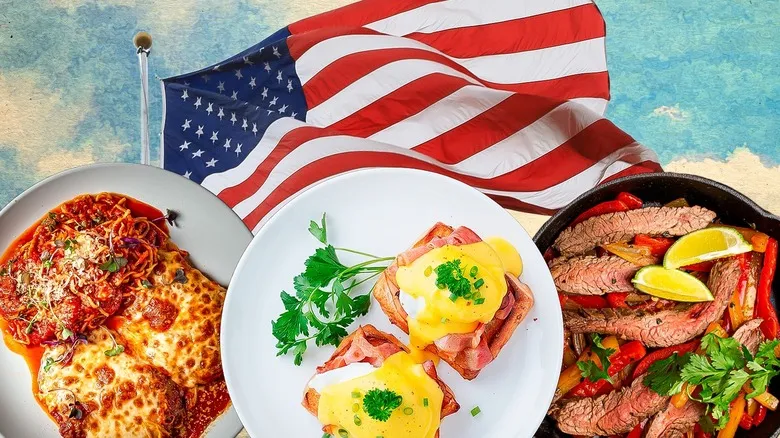French dip
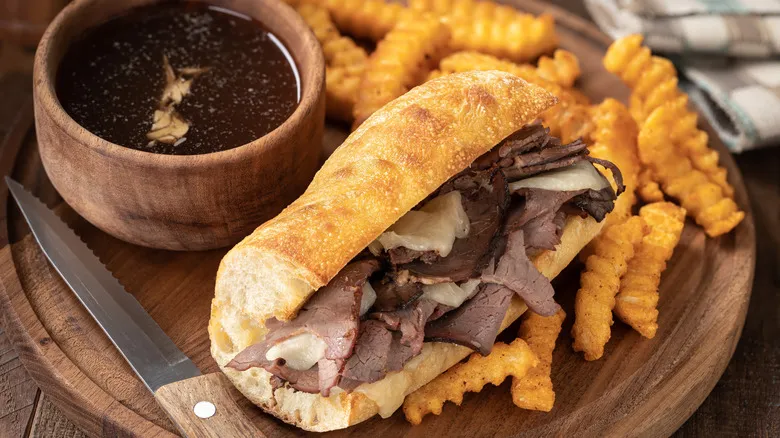
Don’t be misled by the name — the French dip sandwich actually has its roots in California. Two eateries in Los Angeles both assert that they are the original creators of this sandwich, which typically consists of thinly sliced roast beef nestled in a crusty French roll. The sandwich can either be fully immersed in a flavorful jus made from the beef drippings or served with the jus on the side for dipping. So, why is it referred to as a French dip? Only one of the rival restaurants provides a credible explanation.
Philippe The Original claims that the sandwich was invented by its founder, Philippe Mathieu, in 1918. According to the tale, Mathieu was making a roast beef sandwich for a police officer when he accidentally dropped it into the beef drippings. The team at Philippe's theorizes that Mathieu might have named the sandwich in honor of his French heritage, the French roll, or perhaps the policeman's surname. On the other hand, Cole's French Dip offers a different narrative, asserting that chef Jack Garlinghouse created the sandwich in 1908 for a customer suffering from sore gums. However, Cole's does not provide any rationale for the name "French dip."
General Tso's chicken

If you enjoy sweet and tangy Chinese cuisine, General Tso's chicken is likely a perfect choice for you. This dish features battered pieces of chicken coated in a sticky sauce that balances sweetness, sourness, and a hint of spice. It is named after a Chinese general from Hunan province who served in the military during the 19th century, although the dish itself did not originate there. Instead, it was first developed in Taiwan and later adapted in the United States.
The creator of General Tso's chicken was Chef Peng Chang-kuei, who also hailed from Hunan province. After the communist party took control of China in 1949, Peng fled to Taiwan, where he invented the dish. In the 1970s, he moved to New York and opened a restaurant featuring General Tso's chicken on the menu. However, Peng revealed to The New York Times that the original recipe was not sweet; he modified it by adding sugar to cater to American preferences. This new sweet and sour version quickly became popular and is now a beloved item at numerous Chinese-American restaurants throughout the nation.
Eggs Benedict

It's clear why Eggs Benedict has become a staple on brunch menus around the globe. The delightful mix of rich poached eggs, savory Canadian bacon, soft English muffins, and velvety hollandaise sauce is simply irresistible. While it might appear to be a European dish, its origins actually trace back to 19th-century New York City. However, pinpointing its exact birthplace and the story behind its name is somewhat complicated, as there are several competing narratives regarding its creation.
Two restaurants, in particular, both assert that they are the original home of this beloved dish. One tale suggests that chef Charles Ranhofer of Delmonico's crafted the dish for a loyal patron seeking something unique, who was either Mr. or Mrs. Legrand Benedict. Alternatively, another account tells of a man named Lemuel Benedict, who, after a night of revelry, ordered the dish's components at the Waldorf Hotel. The maître d', Oscar Tschirky, was so impressed by the tasty combination that he decided to add it to the menu. Regardless of its true origins, Eggs Benedict has firmly established itself as a key part of American culinary heritage.
Fajitas

When you think of well-known Mexican dishes, fajitas likely come to mind. You might have enjoyed them at a Mexican eatery, featuring tender strips of meat, sautéed peppers, and onions served on a hot platter, accompanied by tortillas and salsa. However, the reality is that fajitas are among several Mexican dishes that did not actually originate in Mexico. They are, in fact, a Tex-Mex invention that emerged around the 1930s.
During the early 20th century, Mexican cowboys working on Texas ranches were often provided with tougher cuts of meat, such as flank steak. These cowboys would quickly grill the meat over an open flame and wrap the strips in tortillas. The term "fajita" translates to "little belt" in Spanish, referencing the shape of the meat. It wasn't until 1969 that the dish gained significant popularity. According to Texas Monthly, that was the year Otilia Garza began serving fajitas on a sizzling platter with a variety of toppings at her Round-Up Restaurant in Pharr, Texas. Other establishments soon followed her lead, and today, it’s rare to find a Tex-Mex restaurant in the United States that doesn’t offer fajitas.
Italian dressing

The term "Italian dressing" is somewhat misleading, as this zesty, herb-infused condiment was actually developed in the United States. However, it does incorporate several ingredients commonly found in Italian cuisine, such as extra virgin olive oil, red wine vinegar, and herbs like oregano and basil. Additionally, the creators of the first Italian salad dressings claimed that their recipes were inspired by their Italian mothers.
You might be familiar with Wish-Bone Italian dressing from your local grocery store. This dressing made its debut in 1948 at Phillip Sollomi's Wish-Bone restaurant in Kansas City. Sollomi, who attributed the recipe to his Sicilian mother, found it so well-received that he began bottling it and eventually sold the restaurant to concentrate on the salad dressing business.
Around the same period, Ken and Florence Hanna from Ken's Steak House in Framingham, Massachusetts, were also gaining recognition for their salad dressing, which was based on a recipe from Florence's Italian mother. They too started bottling their dressing, and today, the company produces over 400 dressings and sauces, including the original Italian dressing that launched their success.
Crab rangoon
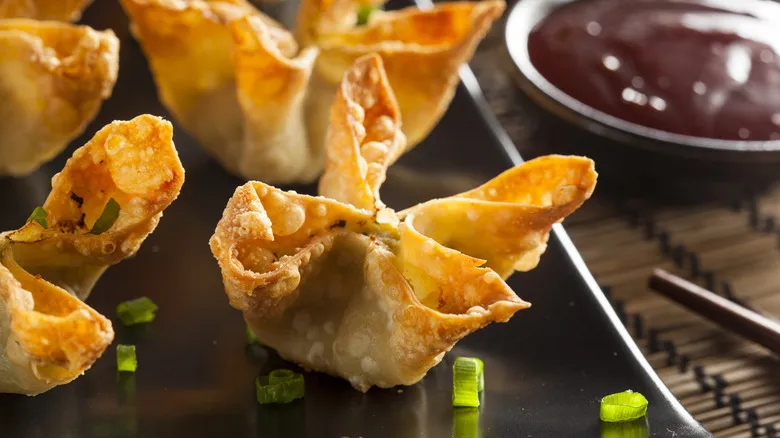
Crab rangoon might seem like a dish from the Far East, but it is actually a distinctly American invention. This deep-fried delicacy usually consists of imitation crab and cream cheese encased in wonton wrappers, then fried to perfection. It is commonly accompanied by a sweet and sour dipping sauce. While it has become a staple at Chinese-American restaurants, its origins trace back to a tiki bar.
In 1934, Victor Bergeron opened a bar named Hinky Dink's in Oakland, California. During this time, tiki culture was gaining popularity in the U.S., prompting Bergeron to embrace an island theme and rebrand the establishment as Trader Vic's. According to legend, he created crab rangoon to complement his menu of Asian and South Pacific-inspired dishes. Eve Bergeron, Victor's granddaughter, shared with Atlas Obscura that he was likely experimenting with ingredients when he came up with the dish.
As for the name? The dish has no genuine ties to Rangoon (now known as Yangon), the capital of Myanmar (formerly Burma). Most sources suggest it was simply an Asian-sounding name that was easy for English speakers to say.
London broil
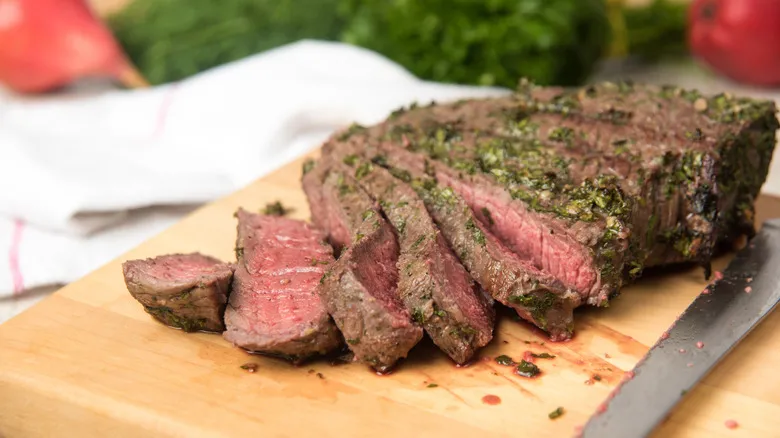
When you browse the selection of steak at a butcher shop or grocery store, you may encounter a cut labeled as London broil. Contrary to what many believe, this steak has no ties to London and is not an officially recognized cut. Instead, London broil refers to a cooking method used for certain cuts of steak. The term likely originated in the United States in the early 19th century, though the reason for its London-inspired name remains a mystery.
London broil involves marinating a tougher cut of steak to enhance its tenderness and then cooking it quickly over high heat. The most commonly used cut for this preparation is flank steak, but the method can be applied to any tough, lean cut of beef. Broiling is a straightforward way to expose the meat to high heat, which is how it got its name. Alternatively, you can pan-fry the steak or grill it. There is no standardized marinade recipe, allowing cooks to experiment with various seasonings.
Chicken Parmesan
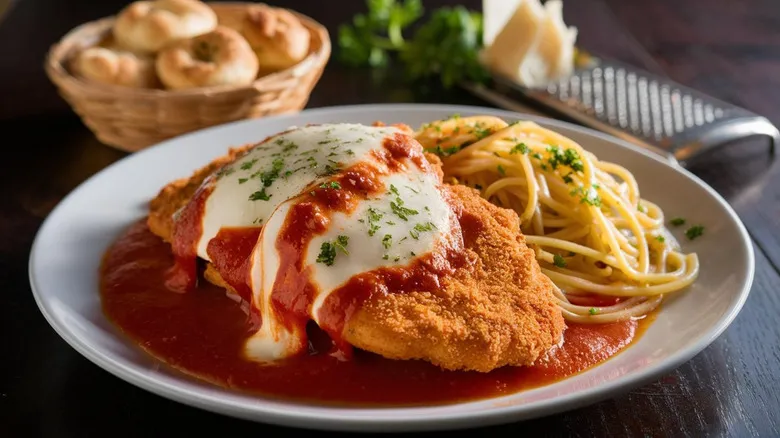
When you dine at an Italian-American restaurant in the United States, there's a strong likelihood that chicken Parmesan will be featured on the menu. This rich "red-sauce" dish consists of a breaded and fried chicken cutlet, generously topped with melted mozzarella cheese and tomato sauce. It's commonly served over spaghetti, enhancing its irresistible appeal. While many people link chicken Parmesan with Italian cuisine, the reality is that you would struggle to find this "Italian" dish in Italy itself.
The roots of chicken Parmesan can be traced back to the Italian diaspora. Upon arriving in America, Italian immigrants discovered that meat was significantly cheaper than in Italy. As a result, they modified some vegetable-based recipes to include meat. Chicken Parmesan is likely a variation of a dish known as melanzane alla Parmigiana, which features breaded eggplant topped with cheese and tomato sauce. It may also have been influenced by cotoletta alla Milanese, a breaded and fried veal dish. Although it draws inspiration from Italian cuisine, the crunchy, cheesy, and tomato-sauce-laden dish we enjoy today is a true Italian-American invention.
English muffins

English muffins might just be the ultimate baked good. With a crunchy exterior and a soft interior, they are heavenly when toasted and slathered with butter that seeps into their nooks and crannies. The versatility of English muffins is impressive; they can serve as a foundation for Eggs Benedict, be transformed into a grilled cheese sandwich, or be torn apart for a panzanella salad. So, who deserves credit for their invention? That would be Samuel Bath Thomas, a British baker who crafted them in his New York bakery.
Thomas relocated to New York at the close of the 19th century and established a bakery in Chelsea, where he created English muffins. Drawing inspiration from crumpets, he employed a distinctive griddle technique that produced air pockets within the muffins and a rough, grainy surface. Instead of slicing the muffins, Thomas split them, achieving the ideal texture for toasting. The muffins quickly gained popularity, eventually making their way across the Atlantic to the U.K., where they are simply referred to as "muffins" or "American muffins."
Chile con carne

The Spanish name for chile con carne might suggest that it has Mexican origins, but in reality, this hearty dish is a staple of Tex-Mex cuisine. Many consider it to be one of the earliest creations in this culinary tradition, featuring a blend of stewed meat, chilies, tomatoes, and spices. The exact origins and creator of chili con carne are subjects of debate, but numerous food historians believe it traces back to San Antonio, Texas.
According to Texas Monthly, the dish may have been developed by Spanish immigrants from the Canary Islands who arrived in San Antonio in the 1700s, bringing with them a spicy stew reminiscent of chili. Others argue that Texas cowboys were the ones who first made it, combining dried meat, chili peppers, and spices into portable bricks that could be easily rehydrated with water during their travels. Additionally, some credit the "Chili Queens," who sold the dish at the San Antonio Military Plaza in the mid-1800s, as its creators. Regardless of its origins, chili has firmly established itself in Texas, ultimately becoming the state's official dish.
Étouffée
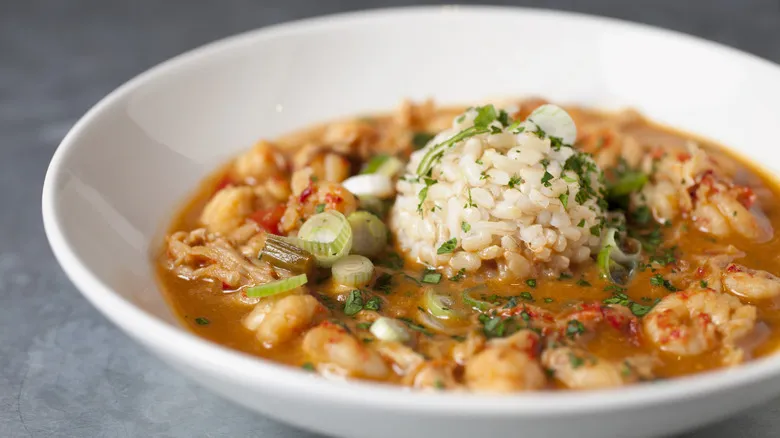
If there's one thing we've discovered from many items on this list, it's that names can often be misleading. This is certainly true for the French-sounding étouffée. This robust dish includes shellfish such as shrimp, crawfish, or crab, all simmered in a roux that produces a rich gravy. Typically, it is served over rice. The name derives from a French term meaning "smothered." However, this flavorful seafood dish did not originate in France; it was created in Louisiana and is deeply rooted in Cajun and Creole culinary traditions.
According to New Orleans Magazine, étouffée was first developed at the Herbert Hotel in the 1920s. The recipe was later passed to Aline Champagne, who popularized it at the Rendezvous Restaurant in Breaux Bridge, where it gained widespread acclaim. Today, you can find numerous variations of the dish that include different ingredients like tomatoes and a range of herbs and spices. However, some elements remain consistent, such as the shellfish, creamy gravy, and a vegetable base that features the "holy trinity" of Cajun and Creole cooking: onion, celery, and bell peppers.
Chop suey

When many people envision chop suey, they associate it with Chinese food. However, the true origins of this stir-fried meat and vegetable dish are as unclear as the sauce it’s served in. Although it may have originated in China, the dish likely bears little resemblance to the version you find at your favorite Chinese takeout restaurant. Furthermore, it probably never achieved the same level of popularity in China as it did in the United States.
According to the Association for Asian Studies, chop suey is likely a variation of a South Chinese stew known as zacui or zaptsui (also transliterated as tsa sui or tsap seui). The name of this stew roughly translates to "a varied mix," highlighting the assortment of meats and vegetables it contains. When Chinese laborers migrated to California during the gold rush in the 1800s, they probably modified the dish based on the ingredients available to them. Chop suey quickly gained traction in America, spreading nationwide and becoming closely associated with Chinese cuisine. While its popularity has diminished somewhat in recent decades, it remains a symbol of Chinese-American culinary culture.
Chimichangas

Chimichangas are essentially deep-fried burritos, but their origins are not in Mexico. These crispy, stuffed delights actually originated in Tucson, Arizona. While the ingredients can vary, they usually consist of meat, rice, beans, and cheese wrapped in a flour tortilla and then deep-fried. The exact origin of chimichangas is difficult to determine, as several restaurants claim to have invented the dish.
One of the most convincing stories attributes the creation of the chimichanga to El Charro Cafe in 1922, where owner Monica Flin accidentally dropped a burrito into the deep fryer. She intended to use a Spanish curse word but opted for "chimichanga" instead, considering the presence of children. Another contender for the invention is Woody Johnson of Macayo's Mexican Food, who also reportedly dropped a burrito into the fryer by mistake. It's worth noting that numerous other establishments also assert their claim to the dish's creation. What we do know for certain is that chimichangas were invented somewhere in Tucson during the 20th century.
Recommended

10 Once Popular Ice Cream Flavors You Never See Today

Why Apple Pie And Cheddar Cheese Is Such An Iconic Pairing

How Tuna Tartare Went From A Last Minute Substitute To Prestige Appetizer
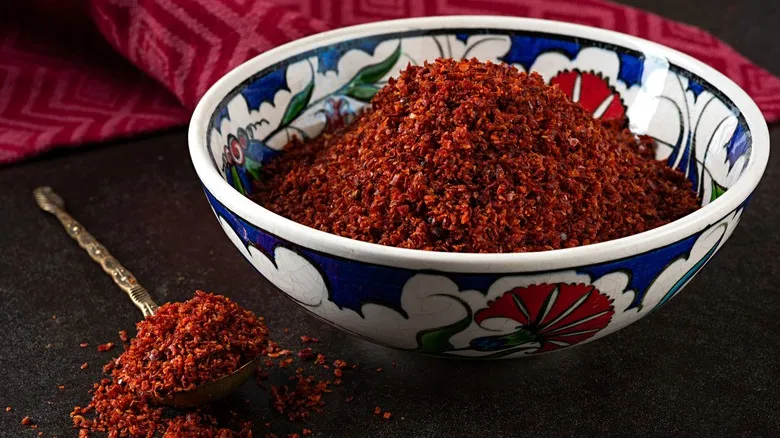
What Exactly Is Paprika Made From?
Next up

